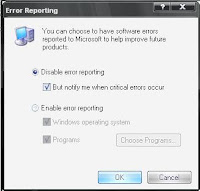Whenever we talk about registry, REGEDIT.exe is the first thing that comes in our mind. But after entering this database and seeing the type of entries we are deterred to start the cleaning process. So here I will be telling how to go about the cleaning process.
There are basically two methods for cleaning the registry. One is manually cleaning the registry using regedit and second is using a Registry cleaner software. As you install and remove software many software leave their impression on the registry and the registry keeps on growing bigger. As a result your system slows down and you may get unnecessary errors. To get rid of this frustration you got to clean your registry.
Manually cleaning the Registry
Registry is a database that holds the configuration of your computer. It allows you to perform many tweaks your operating system does not allow directly. I have discussed many of them in the earlier posts. A Registry can be edited using a registry editor. Windows has been shipped with a default registry editor named “Regedit”. To open regedit go to Start>Run , then type regedit. You’ll reach a window as shown :

Before you touch any part of the registry remember to backup your registry. For that you can either use System Restore or simply select the key you are about to modify in regedit and click File>export. This will create a backup registry file and double clicking this file will restore the value of the key you were trying to manipulate.
Registry editors depict a logical hierarchy of configurations. Registry is divided into six main parts called hives. Each hive has keys and sub keys that have some value assigned to it. These values can be either a DWORD, string or Binary. DWORD stands for double word, string stores values that are of string type and Binary stores the values in terms of 0’s and 1’s.
The six hives store different configuration as follows :
- HKEY_CLASSES_ROOT contains information relating to the user interface, file association mappings and OLE(Object linking and embedding) information.
- HKEY_CURRENT_USER contains information related to the current user of the system.
- HKEY_LOCAL_MACHINE contains information that is common to all the users of the system
- HKEY_USERS contains information about individual users, each of which is identified by a Security ID.
- HKEY_CURRENT_CONFIG contains all the information that is collected when the computer boots up. This information is not stored in secondary storage but is generated every time the computer boots up.
- HKEY_DYN_DATA contains information related to the plug and play devices. The DYN indicates that this information is dynamic which changes as new device is attached.
So with the above basic information you can go on with editing your registry to solve the specific problems you might be facing. But remember to backup the registry.
Using Registry Cleaner Software
If you do not want to take any risk with your Operating System, you can go safe by using a Registry Cleaner Software. These software scan your registry to search for missing references to files etc. They safely bring your system back to the normal working condition. You can clean your registry here. This method is best suited for a novice who is not willing to spend few of his precious hours reinstalling the Operating System.
Some of the famous Registry Cleaners available online are :




